Introduction
In an era where digital transformation is reshaping the business landscape, the significance of Data Center Service Management (DCSM) has never been more pronounced. As organizations strive to optimize their data center operations amidst rising demands and evolving technologies, understanding the frameworks that govern these critical infrastructures becomes essential.
With the global data center market projected to reach approximately $344.06 billion by 2024, the interplay of effective management practices, innovative technologies, and strategic foresight is crucial for maintaining competitive advantage.
This article delves into the key components of successful data center management, the challenges organizations face, and the emerging trends that are set to redefine the future of this vital sector. By exploring these elements, businesses can better navigate the complexities of data center operations and position themselves for sustainable growth in a rapidly changing environment.
Understanding Data Center Service Management
Data center service management (DCSM) represents a crucial framework for managing the operations and optimization of information hubs. It includes the processes, tools, and methodologies essential to data center service management, ensuring that information facilities provide dependable, scalable, and efficient services customized to modern business requirements. As the global data center market is projected to reach approximately $344.06 billion by 2024, the relevance of DCSM cannot be overstated.
Effective data center service management coordinates essential activities such as:
- Capacity planning
- Performance monitoring
- Incident management
- Change management
All strategically aligned with organizational objectives. In light of the ongoing digital transformation, which is expected to drive cloud IT infrastructure spending to $133.7 billion by 2026, a thorough understanding of data center service management (DCSM) is crucial for organizations seeking to harness technology for sustainable growth and innovation. Moreover, as demand keeps increasing in areas such as Asia-Pacific—where facility pricing has escalated significantly, with Singapore surpassing $300 per kW and Tokyo approximately $200 per kW—organizations must implement best practices in data center service management to effectively manage these changing market dynamics.
Significantly, Petroc Taylor, a research specialist focusing on global advancements in information, highlights, "The projected revenue of the worldwide information facility market in 2024 is $344.06 billion," stressing the importance of DCSM in this context. Furthermore, the recent case analysis of Bank of America emphasizes how collaborations, workplace excellence, and sustainability are crucial for addressing contemporary challenges in information facility oversight. As leasing availability in Asia-Pacific has slightly increased due to recently completed facilities, yet demand remains high, companies must stay agile and informed to optimize their operations.
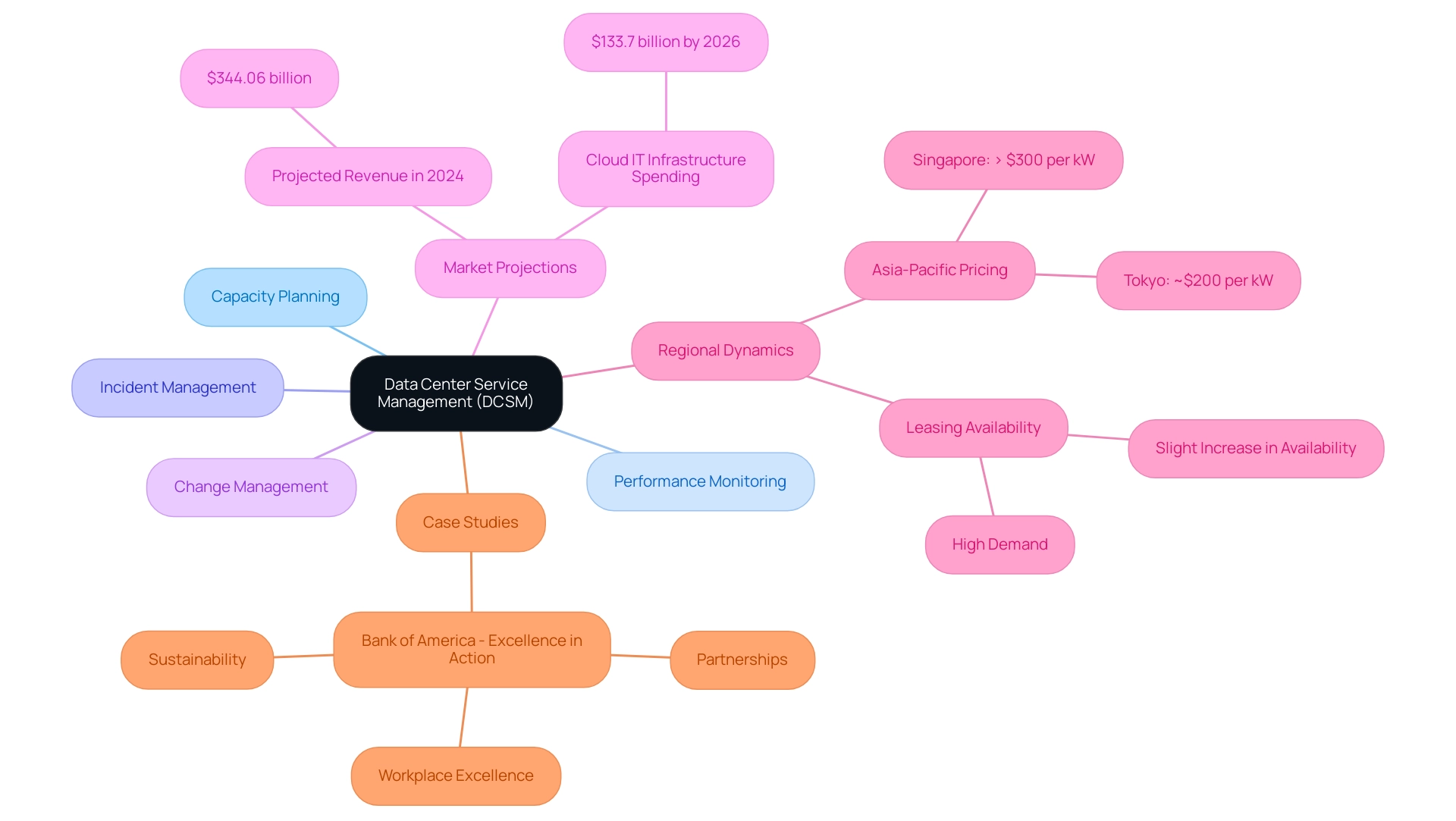
Key Components and Best Practices for Effective Data Center Management
For entities seeking to thrive in information hub management, several fundamental elements are essential:
-
Monitoring and Reporting: Utilizing advanced monitoring tools is crucial for tracking the performance and health of information hub resources in real-time. This proactive approach enables organizations to make informed decisions swiftly, ultimately enhancing operational efficiency. Recent statistics indicate that information hub monitoring tools have experienced substantial adoption rates in 2024, emphasizing their significance in contemporary infrastructure management.
-
Capacity Planning: Effective capacity planning involves regular assessments and adjustments to ensure that resources align with current and projected demands. This practice mitigates the risks of over-provisioning while ensuring that the data center can handle peak loads seamlessly. For instance, successful capacity planning strategies have been implemented in various organizations, showcasing the direct correlation between meticulous planning and optimal resource utilization.
-
Incident Oversight: A structured incident oversight process is vital for promptly addressing and resolving issues, thereby minimizing downtime and preserving service continuity. This is increasingly important in a landscape where the reliability of data services is paramount.
-
Change Oversight: Implementing robust change oversight protocols helps handle updates and modifications to the infrastructure effectively. By ensuring that changes do not disrupt data center service management, organizations can maintain operational integrity and customer satisfaction.
-
Documentation and Training: Comprehensive documentation of processes, systems, and procedures is essential. Aixa Velez underscores the importance of comprehensive documentation in sustaining operational excellence, as stressed in recent reports concerning financial outcomes in the information handling sector. Alongside continuous training initiatives for personnel, this guarantees that team members are well-equipped to oversee the facility efficiently.
-
Real-World Example: A pertinent case study is Datavita's enhancement of its colocation services using FNT's DCIM solutions. This initiative aimed to enhance service delivery and operational efficiency in information hub oversight, illustrating the practical application of these foundational components.
Additionally, statistics related to the industry revenue of 'Information processing, hosting and related activities, web portals' in South Korea from 2012 to 2024 reflect a growing demand for effective information hub oversight, further underscoring the importance of these practices.
By focusing on these components, organizations can not only streamline their information hub operations but also position themselves for sustained success in an evolving technological landscape.
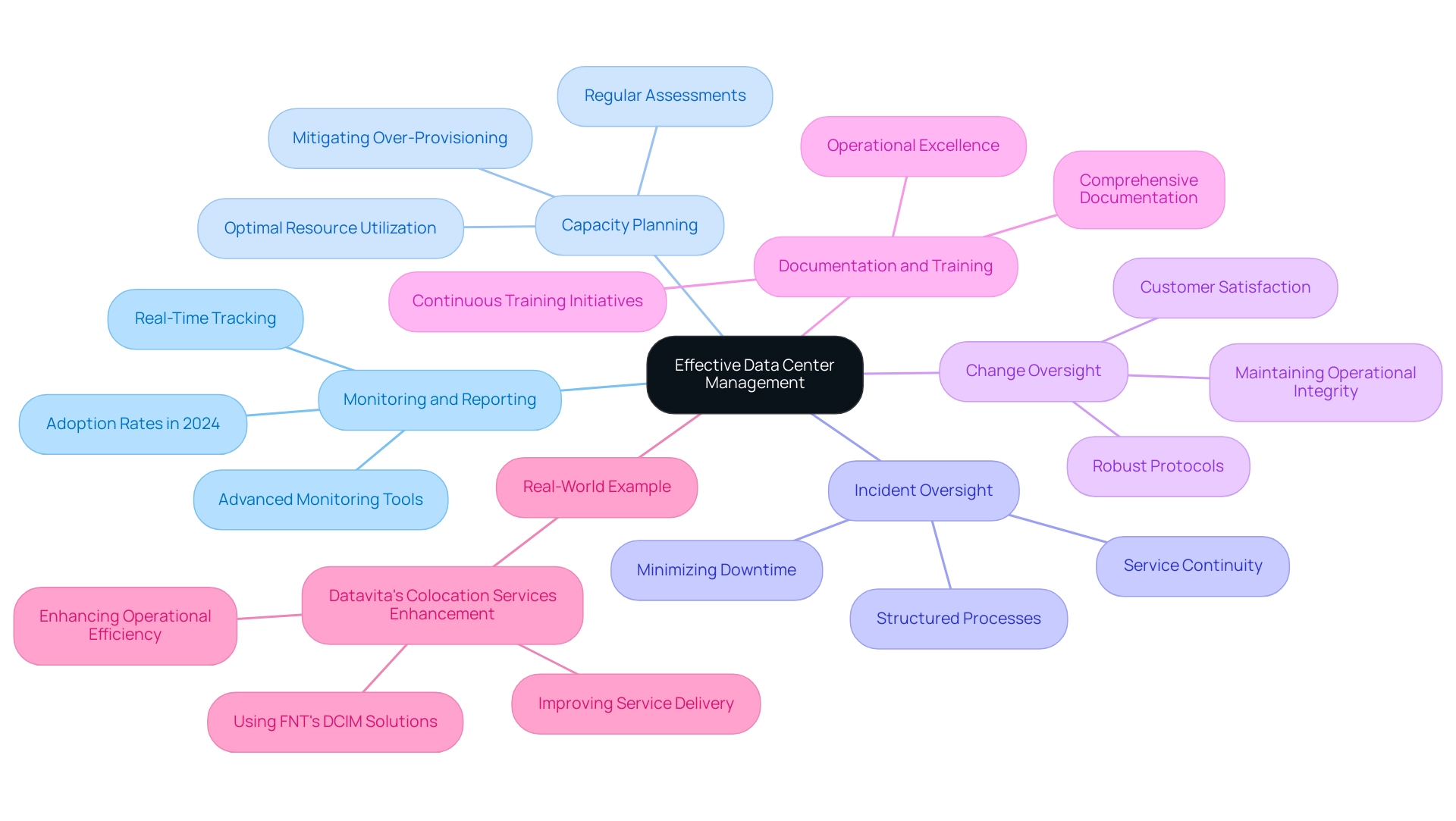
Common Challenges in Data Center Management
The challenges of data center service management can significantly impede operational efficiency. Among the most urgent issues are:
-
Resource Constraints: Organizations frequently encounter limitations in both staffing and budget, which can significantly impede their ability to sustain, enhance, and optimize resources effectively. As of June 2023, areas like Queretaro exemplify this problem, with under 1.2 MW available for lease, highlighting the supply limitations that many facilities face. The challenges posed by resource constraints are further compounded by the operational costs associated with high-density facilities, where each cabinet consumes more than 10kW, leading to much lower operational costs if managed effectively.
-
Scalability Issues: As businesses expand, the complexity and cost of scaling capacity can become daunting, particularly when future growth is not accurately forecasted. The financial implications of scalability issues are particularly stark; in 2024, organizations may face significant costs if they cannot adapt swiftly to increasing demands.
-
Technological Obsolescence: The pace of technological advancement necessitates continuous investment in updates and upgrades, as outdated infrastructure can lead to inefficient operations. Staying ahead of these advancements is crucial to maintain competitive advantage and operational efficacy.
-
Security Threats: Cybersecurity remains a critical concern for center operators. The risks posed by evolving cyber threats require constant vigilance and the implementation of robust security measures to protect sensitive information and maintain information integrity. Recent reports highlight the increasing sophistication of these threats, making it imperative to invest in proactive security strategies.
-
Compliance and Regulation: Adhering to constantly changing compliance requirements poses a significant challenge, especially for entities operating in regulated industries. Making certain that all practices conform to the latest regulations not only protects the entity but also reduces the risk of expensive penalties.
Together, these challenges highlight the need for thorough data center service management strategies that can adapt to the changing environment of technology and regulation. As the forecast for cloud IT infrastructure spending reaches an estimated $133.7 billion by 2026, it is clear that entities must prioritize effective solutions to navigate these obstacles.
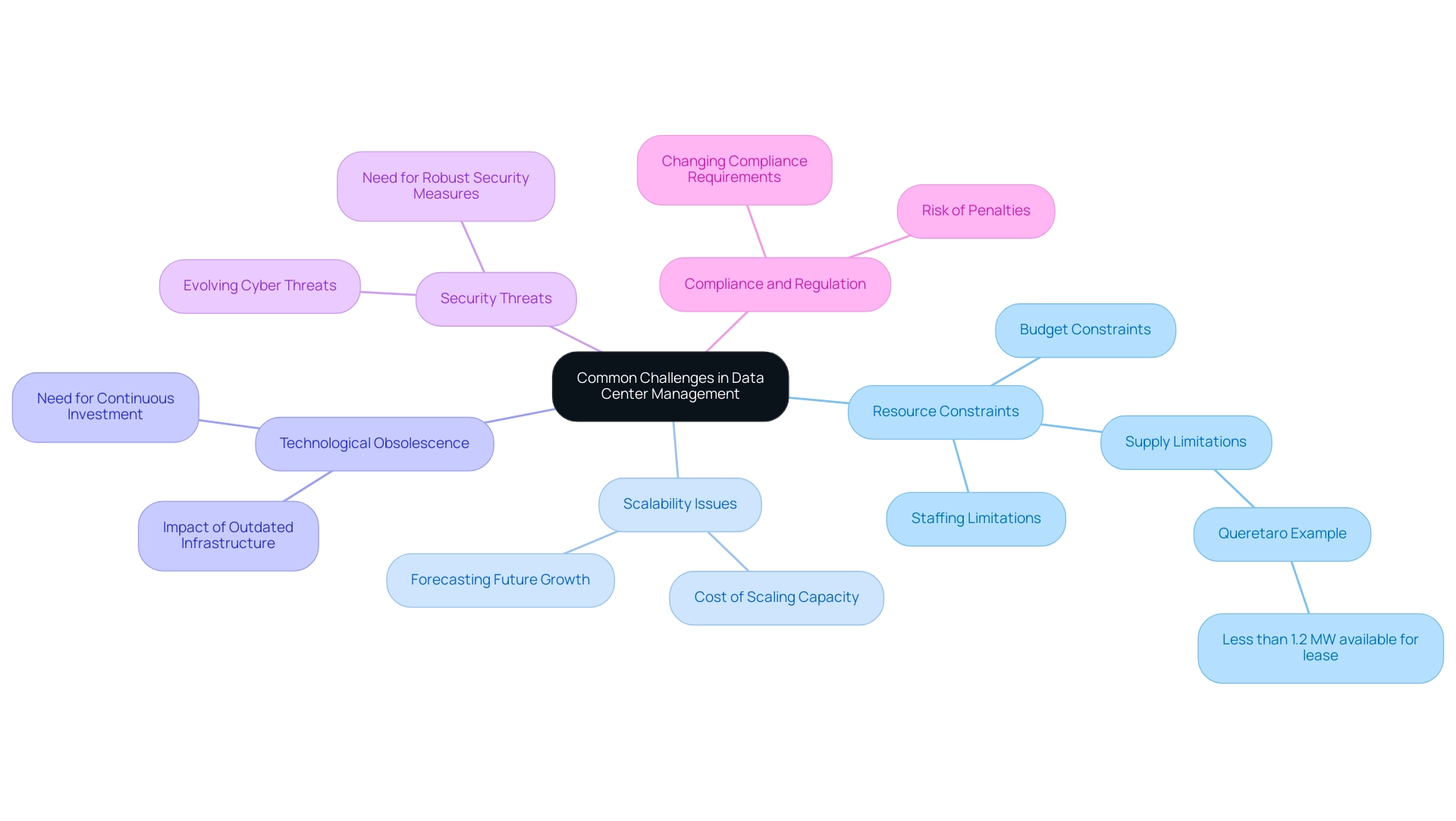
Leveraging Technology for Enhanced Data Center Management
To enhance facility oversight efficiently, companies must embrace a range of cutting-edge technologies that address the changing needs of their infrastructure.
- Virtualization: Implementing virtualization technologies is crucial for maximizing resource utilization and minimizing hardware costs. This approach allows multiple virtual servers to operate on a single physical server, thus enhancing efficiency and flexibility.
As noted by Rahi, By carefully planning and implementing a [virtualized environment](https://rahi.io/the-advantages-of-data-center-virtualization-for-small-and-medium-sized-enterprises), SMEs can achieve significant benefits and improve their overall IT infrastructure, underscoring the value of this strategy.
-
Automation Tools: Automation tools play a vital role in streamlining routine tasks such as backups, updates, and monitoring, significantly increasing operational efficiency while mitigating the risks associated with human error. The application of these tools not only improves reliability but also allows IT staff to concentrate on more strategic initiatives.
-
Data center service management: Investing in comprehensive oversight software as part of data center service management gives companies essential visibility into all aspects of operations. Such software enables data-driven decision-making in the context of data center service management, ensuring that resources are allocated effectively and performance is continuously optimized. This enables entities to flexibly distribute resources according to current demand, guaranteeing that performance standards are upheld even during high usage periods.
-
Analysis Tools: Employing analysis tools is essential for evaluating performance metrics and identifying areas suitable for enhancement. By enabling proactive management of operations in facilities, analytics tools assist organizations in staying ahead of potential issues and improving overall efficiency.
The importance of these technologies is particularly clear in sectors such as eCommerce and digital media, which together represent about 35% of facility usage due to the increasing demand for online services. This reality emphasizes the urgent need for strong infrastructure to support these industries effectively. Furthermore, during Japan IT Week, which gathered more than 90,000 participants, the emphasis on information hub solutions was essential, showcasing the sector's vital role in facilitating digital transformation.
Furthermore, companies such as Wesco Group illustrate thorough information hub oversight solutions that meet these changing demands.
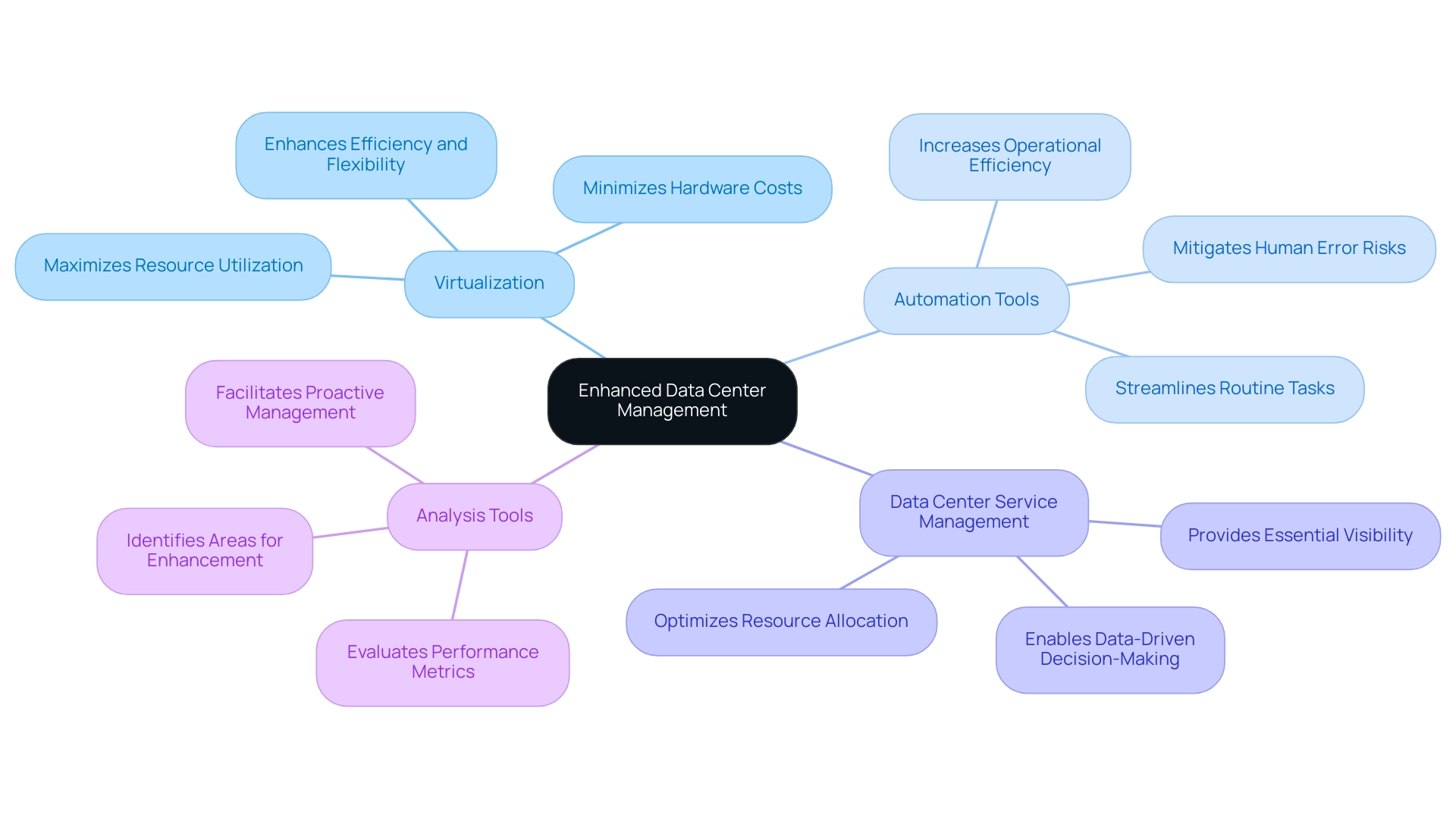
Future Trends in Data Center Service Management
The landscape of data center service management is undergoing transformative changes, driven by several key trends that organizations must closely monitor:
-
Increased Adoption of Edge Computing: The proliferation of IoT devices has made edge computing indispensable for real-time data processing. This approach minimizes latency and reduces bandwidth usage, ensuring that information is handled closer to its source. Since 2015, interest in edge computing has surged dramatically, evidenced by a significant increase in academic publications—from 720 in 2015 to over 42,700 in 2023—demonstrating the growing recognition of its importance. Furthermore, by 2028, the mobile consumer segment is expected to lead the IT power footprint share for edge computing infrastructure with 21.70%, highlighting the diverse impact of edge computing across multiple industries.
-
AI and Machine Learning Integration: The incorporation of AI and machine learning technologies into facilities operations is transforming how entities manage their resources. Predictive maintenance is becoming standard practice, optimizing resource allocation and enhancing security protocols. Hewlett Packard Enterprise (HPE) recently introduced the Edgeline 8000, a rugged edge server designed for demanding environments. According to HPE, "the Edgeline 8000 is built to withstand harsh conditions while delivering robust performance," showcasing the industry's commitment to innovation in this area.
-
Sustainability Initiatives: With increasing awareness of environmental issues, organizations are prioritizing sustainability in their operations. The focus is shifting toward energy-efficient technologies and practices that not only mitigate environmental impact but also drive cost savings. The $5 billion investment in Google's Council Bluffs facility exemplifies the scale of commitment to sustainability and innovation in infrastructure design.
-
Hybrid Information Center Models: As companies pursue greater flexibility and scalability, hybrid information center models that merge on-premises infrastructure with cloud solutions are gaining traction. This method enables companies to customize their information management strategies to satisfy particular needs and requirements.
-
Enhanced Security Measures: Given the evolving landscape of cyber threats, organizations are investing significantly in advanced security technologies. Implementing AI-driven threat detection systems and adopting zero-trust security models are becoming essential strategies to protect sensitive information and maintain operational integrity.
These trends not only reflect the current state of data center service management, but they also pave the way for future advancements in the industry.
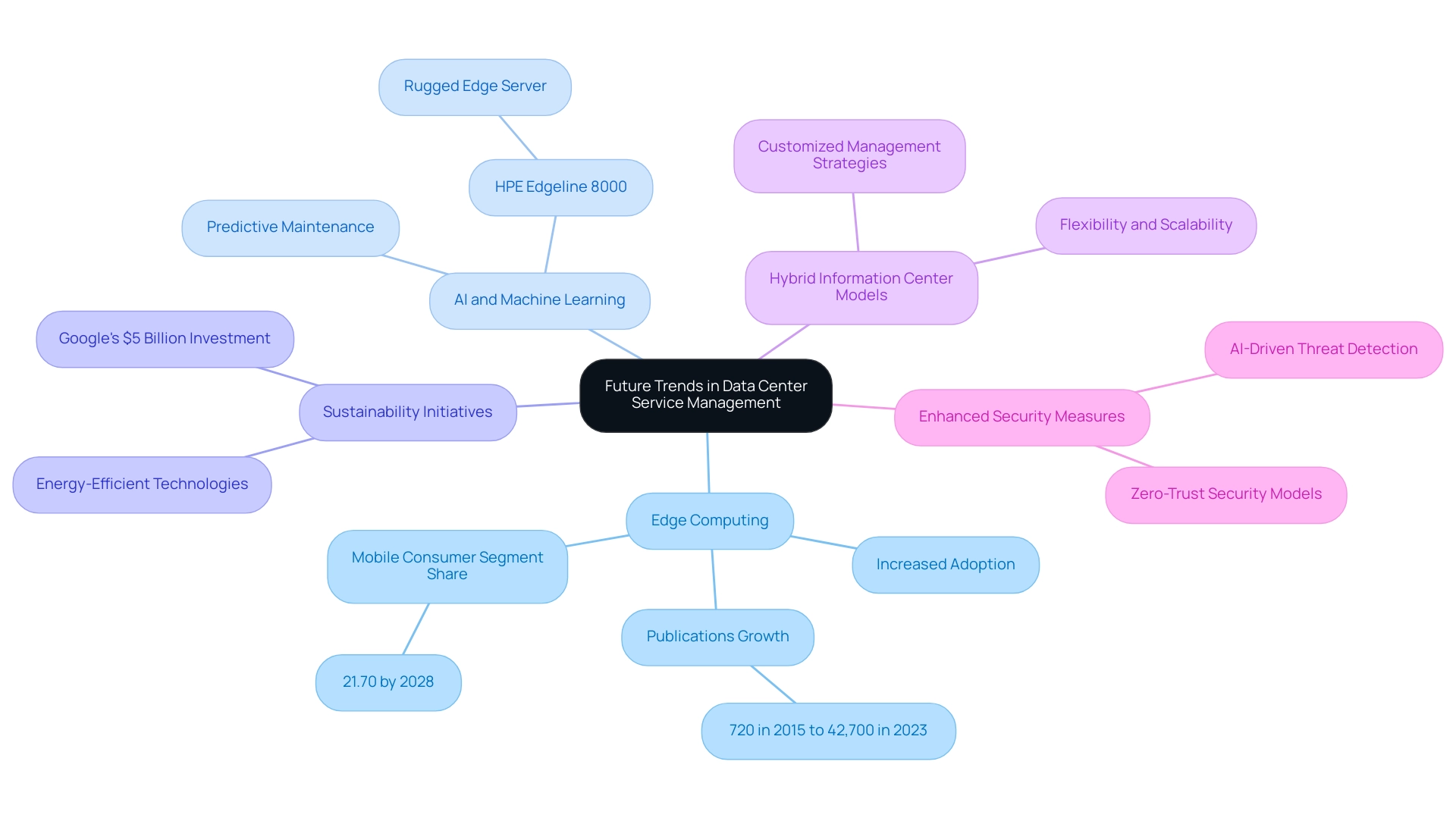
Conclusion
The exploration of Data Center Service Management (DCSM) underscores its critical role in navigating the complexities of modern data center operations. As highlighted, effective DCSM integrates essential components such as:
- Monitoring
- Capacity planning
- Incident management
- Change management
All of which are pivotal for optimizing performance and ensuring reliability. Organizations that prioritize these best practices are better positioned to mitigate the challenges posed by:
- Resource constraints
- Scalability issues
- Technological obsolescence
- Evolving security threats
In addition, leveraging advanced technologies such as:
- Virtualization
- Automation
- Data analytics
Is paramount for enhancing operational efficiency. The integration of cloud services and the emphasis on real-time data processing through edge computing further illustrate the need for organizations to adapt to the dynamic demands of the digital landscape. As the industry evolves, emerging trends like:
- AI integration
- Sustainability initiatives
Are set to redefine data center management, providing organizations with innovative tools to drive growth and maintain competitive advantage.
Ultimately, understanding and implementing effective DCSM practices is not merely an operational necessity; it is a strategic imperative for organizations aiming to thrive in an increasingly complex and competitive environment. By embracing these frameworks and trends, businesses can ensure their data centers not only meet current demands but also adapt to future challenges, paving the way for sustainable growth and innovation in the digital age.




